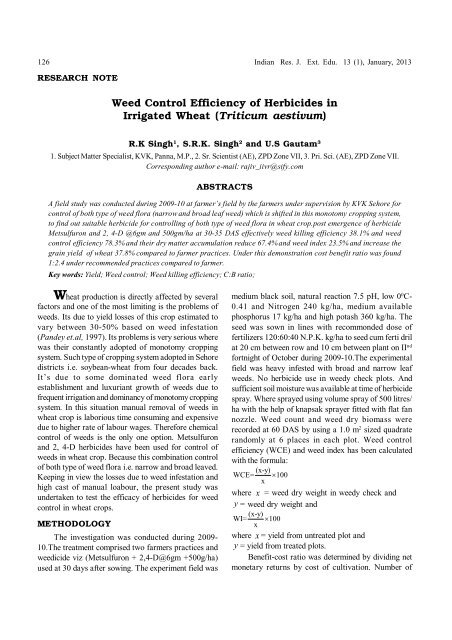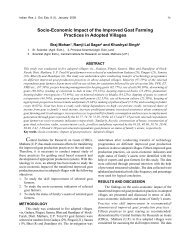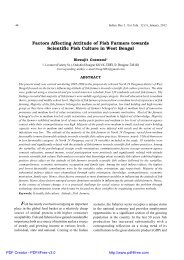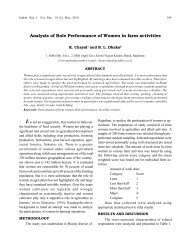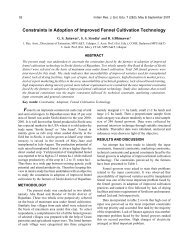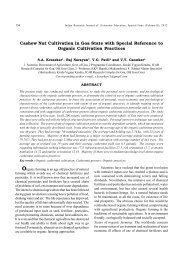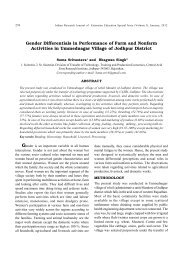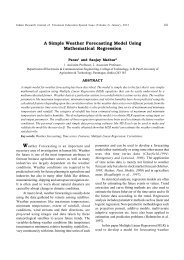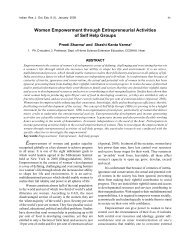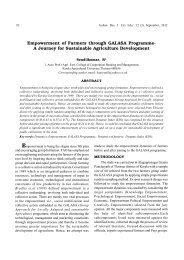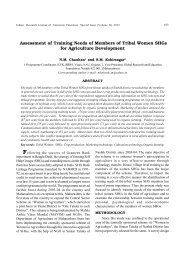Weed Control Efficiency of Herbicides in Irrigated Wheat - Seea.org.in
Weed Control Efficiency of Herbicides in Irrigated Wheat - Seea.org.in
Weed Control Efficiency of Herbicides in Irrigated Wheat - Seea.org.in
Create successful ePaper yourself
Turn your PDF publications into a flip-book with our unique Google optimized e-Paper software.
126 Indian Res. J. Ext. Edu. 13 (1), January, 2013RESEARCH NOTE<strong>Weed</strong> <strong>Control</strong> <strong>Efficiency</strong> <strong>of</strong> <strong>Herbicides</strong> <strong>in</strong><strong>Irrigated</strong> <strong>Wheat</strong> (Triticum aestivum)R.K S<strong>in</strong>gh 1 , S.R.K. S<strong>in</strong>gh 2 and U.S Gautam 31. Subject Matter Specialist, KVK, Panna, M.P., 2. Sr. Scientist (AE), ZPD Zone VII, 3. Pri. Sci. (AE), ZPD Zone VII.Correspond<strong>in</strong>g author e-mail: rajiv_iivr@sify.comABSTRACTSA field study was conducted dur<strong>in</strong>g 2009-10 at farmer’s field by the farmers under supervision by KVK Sehore forcontrol <strong>of</strong> both type <strong>of</strong> weed flora (narrow and broad leaf weed) which is shifted <strong>in</strong> this monotomy cropp<strong>in</strong>g system,to f<strong>in</strong>d out suitable herbicide for controll<strong>in</strong>g <strong>of</strong> both type <strong>of</strong> weed flora <strong>in</strong> wheat crop.post emergence <strong>of</strong> herbicideMetsulfuron and 2, 4-D @6gm and 500gm/ha at 30-35 DAS effectively weed kill<strong>in</strong>g efficiency 38.1% and weedcontrol efficiency 78.3% and their dry matter accumulation reduce 67.4% and weed <strong>in</strong>dex 23.5% and <strong>in</strong>crease thegra<strong>in</strong> yield <strong>of</strong> wheat 37.8% compared to farmer practices. Under this demonstration cost benefit ratio was found1:2.4 under recommended practices compared to farmer.Key words: Yield; <strong>Weed</strong> control; <strong>Weed</strong> kill<strong>in</strong>g efficiency; C:B ratio;<strong>Wheat</strong> production is directly affected by severalfactors and one <strong>of</strong> the most limit<strong>in</strong>g is the problems <strong>of</strong>weeds. Its due to yield losses <strong>of</strong> this crop estimated tovary between 30-50% based on weed <strong>in</strong>festation(Pandey et.al, 1997). Its problems is very serious wherewas their constantly adopted <strong>of</strong> monotomy cropp<strong>in</strong>gsystem. Such type <strong>of</strong> cropp<strong>in</strong>g system adopted <strong>in</strong> Sehoredistricts i.e. soybean-wheat from four decades back.It’s due to some dom<strong>in</strong>ated weed flora earlyestablishment and luxuriant growth <strong>of</strong> weeds due t<strong>of</strong>requent irrigation and dom<strong>in</strong>ancy <strong>of</strong> monotomy cropp<strong>in</strong>gsystem. In this situation manual removal <strong>of</strong> weeds <strong>in</strong>wheat crop is laborious time consum<strong>in</strong>g and expensivedue to higher rate <strong>of</strong> labour wages. Therefore chemicalcontrol <strong>of</strong> weeds is the only one option. Metsulfuronand 2, 4-D herbicides have been used for control <strong>of</strong>weeds <strong>in</strong> wheat crop. Because this comb<strong>in</strong>ation control<strong>of</strong> both type <strong>of</strong> weed flora i.e. narrow and broad leaved.Keep<strong>in</strong>g <strong>in</strong> view the losses due to weed <strong>in</strong>festation andhigh cast <strong>of</strong> manual loabour, the present study wasundertaken to test the efficacy <strong>of</strong> herbicides for weedcontrol <strong>in</strong> wheat crops.METHODOLOGYThe <strong>in</strong>vestigation was conducted dur<strong>in</strong>g 2009-10.The treatment comprised two farmers practices andweedicide viz (Metsulfuron + 2,4-D@6gm +500g/ha)used at 30 days after sow<strong>in</strong>g. The experiment field wasmedium black soil, natural reaction 7.5 pH, low 0 0 C-0.41 and Nitrogen 240 kg/ha, medium availablephosphorus 17 kg/ha and high potash 360 kg/ha. Theseed was sown <strong>in</strong> l<strong>in</strong>es with recommonded dose <strong>of</strong>fertilizers 120:60:40 N.P.K. kg/ha to seed cum ferti drilat 20 cm between row and 10 cm between plant on II ndfortnight <strong>of</strong> October dur<strong>in</strong>g 2009-10.The experimentalfield was heavy <strong>in</strong>fested with broad and narrow leafweeds. No herbicide use <strong>in</strong> weedy check plots. Andsufficient soil moisture was available at time <strong>of</strong> herbicidespray. Where sprayed us<strong>in</strong>g volume spray <strong>of</strong> 500 litres/ha with the help <strong>of</strong> knapsak sprayer fitted with flat fannozzle. <strong>Weed</strong> count and weed dry biomass wererecorded at 60 DAS by us<strong>in</strong>g a 1.0 m 2 sized quadraterandomly at 6 places <strong>in</strong> each plot. <strong>Weed</strong> controlefficiency (WCE) and weed <strong>in</strong>dex has been calculatedwith the formula:(x-y)WCE= 100xwhere x = weed dry weight <strong>in</strong> weedy check andy = weed dry weight and(x-y)WI= 100xwhere x = yield from untreated plot andy = yield from treated plots.Benefit-cost ratio was determ<strong>in</strong>ed by divid<strong>in</strong>g netmonetary returns by cost <strong>of</strong> cultivation. Number <strong>of</strong>
Indian Res. J. Ext. Edu. 13 (1), January, 2013 127Table 1. Effect <strong>of</strong> herbicide on weed spectrum.No.<strong>of</strong> No.<strong>of</strong> Total Use <strong>of</strong> No.<strong>of</strong> No.<strong>of</strong> Total no. WKE WI WDM WCETreatments BLW NLW weeds herbicid BLW NLW <strong>of</strong> weeds (%) gm/m 2 (%)/m 2 /m 2 /m 2 /m 2 /m 2 /m 225 DAS 60 DASRP 10 6.5 16.5 25 DAS 4.0 2.1 6.1 38.1% -23.5 41. 78.3FP 9.0 7.0 16.0 9.0 15.0 24.0 - - 189 -RP-Recommended practices, FP- Farmer practices, DAS - Days after sow<strong>in</strong>gBLW-Broad leaf weed, NLW-Narrow leaf weed, WKE-<strong>Weed</strong> kill<strong>in</strong>g efficiency,WI-<strong>Weed</strong> <strong>in</strong>dex, WDM-<strong>Weed</strong> dry matter, WCE-weed control efficiencyTable 2. Effect <strong>of</strong> herbicide on yield attributes and economics <strong>of</strong> wheatTreat Total no. No. % <strong>of</strong> <strong>in</strong> No.<strong>of</strong> Test Yield Incr- Straw G:S Cost <strong>of</strong> GR NR B:Cments <strong>of</strong> tillers effective effective gra<strong>in</strong>s weight q/ha eas yield ratio cultiv- ratio/m2 tillers/m2 tillers /ear gm(1000 yield q/ha ationseeds) (%)RP 356.1 323.7 10.0 38.5 37.5 46.7 37.8 63.0 1:1.35 21500.0 51406 29906.0 1:2.4FP 328.6 267.2 23.0 37.5 36.6 37.8 - 52.9 1:1.40 20500.0 34545 140450. 1:2.0RP-Recommended practices, FP- Farmer practices, GS-Gra<strong>in</strong> Straw ratio,GR-Grass return, NR-Net return, B:C –Benefit cast ratioproductive tillers, no. <strong>of</strong> gra<strong>in</strong>s /ear, test wt and gra<strong>in</strong>yield on personal contact basis.RESULTS AND DISCUSSIONHighest weed population and dry weight <strong>of</strong> weedswere recorded <strong>in</strong> weedy check compared torecommended practices. The crop weed competitionwas markedly reduced by weed control treatments asis evident from the significant decrease <strong>in</strong> weedpopulation, dry matter accumulation, weed kill<strong>in</strong>gefficiency, weed control efficiency and weed control<strong>in</strong>dex 6.1, 41g/m 2 , 38.1%, 67.4%, -23.5%.respectivelyby remov<strong>in</strong>g the weeds under herbicide spray(metsufuron+2,4-D) (Table 1) which was significantlysuperior to farmers practices.Similar result were reported by (Pandey et.al.2001), whenever pool data <strong>in</strong>dicated thatmetsulfuron+2,4-D @ 6g and 500g/ha was mosteffective herbicide for controll<strong>in</strong>g <strong>of</strong> both type <strong>of</strong> weedflora i.e narrow and broad leaf weeds throughout thegrow<strong>in</strong>g season. Because Met sulfuron kills broadleafweeds and some annual grasses through foliar and soilactivity, that <strong>in</strong>hibits cell division <strong>in</strong> shoots and roots.And 2,4–D is absorbed through the leaves and istranslocated to the meristems for plant death byunsusta<strong>in</strong>able growth ensues, caus<strong>in</strong>g stem curl-over,leaf wither<strong>in</strong>g from cited by (Tiwari et.al, 1997; Dixitet.al, 1997 and Malik, 1992).Gra<strong>in</strong> yield : <strong>Weed</strong> competition lowered crop yield37.8% under weedy check compared to herbicidaleffect along with recommended dose fertilizers (Table2).This may be attributed to marked decrease <strong>in</strong> weedpopulation, weed dry weight and there by better cropgrowth, <strong>in</strong>creased productive tillers, no. <strong>of</strong> gra<strong>in</strong>s/ears,test weight, gra<strong>in</strong> and straw yield 323.7, 39, 37.5,46.7and 63.0 q/ha respectively compared to farmer practices267.7, 36.0, 36.6,37.8 and 54.1 q/ha, through betterutilization <strong>of</strong> available resource like fertilizers, water,sunlight and space due to less competition <strong>of</strong> crop andweeds compared to farmers practices. The maximumyield was achieved with the application <strong>of</strong> metsufuron+2,4-D, <strong>in</strong>crease <strong>in</strong> gra<strong>in</strong> yield <strong>of</strong> wheat crop ow<strong>in</strong>g tobetter control <strong>of</strong> weeds, particularly <strong>of</strong> narrow andbroad leaf weed (Dixit and Bhan (1997), Balyan(1999), Virendra et.al (2004) and Jitendra Pandey(2002).Economic impact: The economic impact as Net returnand cost benefit ratio was calculated (Table 2), whichfound Rs 29906.0 and 1:2.4 recommended practicesas compared to farmer practices 140450.0 and 1:2.0which <strong>in</strong>dicate the directly response <strong>of</strong> weed controlby spray <strong>of</strong> herbicide.CONCLUSIONHerbicide significantly affected the mean
128 Indian Res. J. Ext. Edu. 13 (1), January, 2013difference for all the parameter, while the ma<strong>in</strong> effect<strong>of</strong> control <strong>of</strong> broad leaved weed. This comb<strong>in</strong>ationexhibited the best performance through effective broadleaved weed control. Therefore this comb<strong>in</strong>ation arerecommended for manag<strong>in</strong>g dom<strong>in</strong>ated broad leavedweed flora and better economic returns.Paper received on : December 01, 2012Accepted on : December 29, 2012REFERENCESDixit, A. and Bhan Y.M. (1997). <strong>Weed</strong> control effeciency <strong>of</strong> isoproturon applied at different concentration and its comb<strong>in</strong>ationwith 2,4-D <strong>in</strong> wheat. Indian J. <strong>Weed</strong> Science, 29 (1,2) : 11-14.Balyan, R.S. (1999). Efficacy <strong>of</strong> sulfosulfuron tralkxy and metribz<strong>in</strong> applied alone and tanks mmix on weeds <strong>in</strong> wheat.Indian J. <strong>Weed</strong> Science, 31 (1&2) : 80-83.Gupta, Virender Kumar; Kumar, Sanjeev and Arv<strong>in</strong>d Kumar S<strong>in</strong>gh (2004). Yield quality <strong>of</strong> wheat (Triticum aestivium) as<strong>in</strong>fluenced by sulphur nutrition and weed management . Indian J. Agriculture Science, 74 (5) : 254-56.Malik, R.S.,Panwar R.S. and Malik R.K. (1992). Chemical control <strong>of</strong> broad leaf and grassy weeds <strong>in</strong> wheat (Triticum aestivum).Indian J. Agronomy, 37 : 324-346.Tewari, A.N.; Hussa<strong>in</strong> K. and S<strong>in</strong>gh B. (1997). Evaluation <strong>of</strong> herbicids <strong>in</strong> pea (Pisum sativum)+Mustard (Brassica juncea)<strong>in</strong>tercropp<strong>in</strong>g. Indian J. <strong>Weed</strong> Science, 29 (3&4) : 80-83.Virender Sardana (2001).Evalution <strong>of</strong> herbicides for control <strong>of</strong> weeds <strong>in</strong> durum wheat (Triticum durum).Indian J. Agriculture Science, 71 (9) : 602-4Jitendra Pandey (2002). Effect <strong>of</strong> dose and mode <strong>of</strong> metribuz<strong>in</strong>e application on phalaris m<strong>in</strong>or and yield <strong>of</strong> wheat (Triticumaestivium) . Indian J. Agriculture Science.72 (1):11-13.Pandey, J.; S<strong>in</strong>gh, R. and Verma, A.K. (2001). Influence <strong>of</strong> herbicides on weed management <strong>in</strong> true potato. Acta AgronomicaHungarica, 49 : 183-87Pandey J. and S<strong>in</strong>gh R. (1997).weed control <strong>in</strong> wheat is key to higher production.Indian farm<strong>in</strong>g, 47 (8) : 4-7.


